
|
|
|
| synonym |
|
| description |
A dark, blackish-brown species with two distinctive yellowish marks down the back. The wings are mostly concolorous with the rest of the body, with rufous-tinted tips. Sexes can be distinguished from one another by the length of the horn- in females, the horn is noticeably long and prominent, while in males the horn is much smaller, sometimes nothing more than a little nub. Egg masses are whitish in color, resembling raised shells on a stem.
See here for a nice depiction of the life cycle of nymphs of this genus. |
| distribution |
Southeastern North America |
| abundance |
Recently recorded from the mountains, likely more abundant in this region. |
| seasonal_occurrence | |
| habitat |
Has been found on roadsides near forest edge. |
| plant associates |
Silverbell (Halesia spp.) |
| behavior |
Has been found to be tended by ants in the genus Formica. |
| comments |
Recent studies have shown that there are a number of undescribed species within the Enchenopa binotata species complex, with each undescribed species feeding on a specific, different host plant. These host plants include (but are not limited to) Cercis (redbud), Juglans (walnut), and Viburnum. Adults of the various species cannot be distinguished from one another, so it is imperative to record the host plant that Enchenopa individuals are found on. Some nymphs of this complex are distinctive enough to be identified to species: see here.
This species at least seems to be in the process of being described, unlike most other members of this species-complex. |
status |
[Native:]
[Introduced:]
[Extirpated:] | | list_type |
[Official:]
[Provisional:] |
| adult_id | Unmistakable and widely known Identifiable from good quality photos of unworn specimens
Identifiable from photos showing undersides, or other specialized views [e.g., legs, face]
Identifiable only by close inspection of structural features or by DNA analysis NULL |
| nymph_id | Unmistakable and widely known Identifiable from good quality photos, especially where associated with known host plants
Identifiable from close inspection of specimens or by DNA analysis
Identifiable only through rearing to adulthood NULL |
| G_rank |
|
| S_rank |
|
| rank_comments |
|
| tribe |
Membracini |
| subgenus |
|
Species Photo Gallery for Enchenopa on-halesia Undescribed Enchenopa on Silverbell |
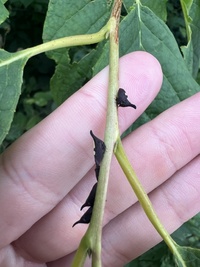 | Photo by: Samuel Blumenfeld; Julie Tuttle
Haywood Co.
Comment: Only H. teraptera seen in area. ~20 sapling growing off roadside, so high light environment. | 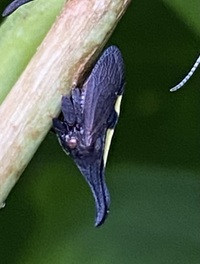 | Photo by: Sam Blumenthal and Julie Tuttle
Haywood Co.
Comment: The hoppers were discovered by Sam Blumenthal, though I also took photos and posted an iNaturalist observation. There may have been many other individuals of the tree hopper on this tree -- we didn't do a thorough search. There was a Formica subsericea ant "stationed" on the twig with these hoppers -- its presence seemed to be more than incidental. Ant observation here: https://www.inaturalist.org/observations/174971413 |
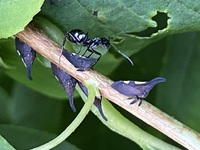 | Photo by: Sam Blumenthal and Julie Tuttle
Haywood Co.
Comment: The hoppers were discovered by Sam Blumenthal, though I also took photos and posted an iNaturalist observation. There may have been many other individuals of the tree hopper on this tree -- we didn't do a thorough search. There was a Formica subsericea ant 'stationed' on the twig with these hoppers -- its presence seemed to be more than incidental. Ant observation here: https://www.inaturalist.org/observations/174971413 |  | Photo by: Sam Blumenthal and Julie Tuttle
Haywood Co.
Comment: The hoppers were discovered by Sam Blumenthal, though I also took photos and posted an iNaturalist observation. There may have been many other individuals of the tree hopper on this tree -- we didn't do a thorough search. There was a Formica subsericea ant 'stationed' on the twig with these hoppers -- its presence seemed to be more than incidental. Ant observation here: https://www.inaturalist.org/observations/174971413 |
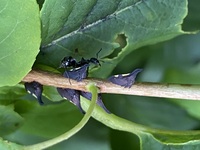 | Photo by: Sam Blumenthal and Julie Tuttle
Haywood Co.
Comment: The hoppers were discovered by Sam Blumenthal, though I also took photos and posted an iNaturalist observation. There may have been many other individuals of the tree hopper on this tree -- we didn't do a thorough search. There was a Formica subsericea ant 'stationed' on the twig with these hoppers -- its presence seemed to be more than incidental. Ant observation here: https://www.inaturalist.org/observations/174971413 | 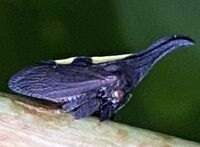 | Photo by: Sam Blumenthal and Julie Tuttle
Haywood Co.
Comment: The hoppers were discovered by Sam Blumenthal, though I also took photos and posted an iNaturalist observation. There may have been many other individuals of the tree hopper on this tree -- we didn't do a thorough search. There was a Formica subsericea ant "stationed" on the twig with these hoppers -- its presence seemed to be more than incidental. Ant observation here: https://www.inaturalist.org/observations/174971413 |
|

 »
»

 »
»